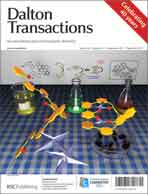The amidine complexes cis-[L2PtNH![[double bond, length as m-dash]](https://www.rsc.org/images/entities/char_e001.gif) C(R){1-MeCy(-2H)}]NO3 (R = Me, 1a; Ph, 1b, Me3C, 1c; Ph2(H)C, 1d) and cis-[L2PtNH
C(R){1-MeCy(-2H)}]NO3 (R = Me, 1a; Ph, 1b, Me3C, 1c; Ph2(H)C, 1d) and cis-[L2PtNH![[double bond, length as m-dash]](https://www.rsc.org/images/entities/char_e001.gif) C(R){9-MeAd(-2H)}]NO3 (R = Me, 2a; Ph, 2b; Me3C, 2c; Ph2(H)C, 2d), are formed when cis-[L2Pt(μ-OH)]2(NO3)2 (L = PPh3) reacts with 1-methylcytosine (1-MeCy) and 9-methyladenine (9-MeAd) in solution of MeCN, PhCN, Me3CCN and Ph2(H)CCN. Reaction of 1a,b and 2a,b with HCl affords the protonated amidines [NH2
C(R){9-MeAd(-2H)}]NO3 (R = Me, 2a; Ph, 2b; Me3C, 2c; Ph2(H)C, 2d), are formed when cis-[L2Pt(μ-OH)]2(NO3)2 (L = PPh3) reacts with 1-methylcytosine (1-MeCy) and 9-methyladenine (9-MeAd) in solution of MeCN, PhCN, Me3CCN and Ph2(H)CCN. Reaction of 1a,b and 2a,b with HCl affords the protonated amidines [NH2![[double bond, length as m-dash]](https://www.rsc.org/images/entities/char_e001.gif) C(R){1-MeCy(-H)}]NO3 (R = Me, 3a; Ph, 3b) and [NH2
C(R){1-MeCy(-H)}]NO3 (R = Me, 3a; Ph, 3b) and [NH2![[double bond, length as m-dash]](https://www.rsc.org/images/entities/char_e001.gif) C(R){9-MeAd(-H)}]NO3 (R = Me, 4a; Ph, 4b) and cis-(PPh3)2PtCl2 in quantitative yield. Treatment of 3b and 4b with NaOH allows the isolation of the neutral benzimidamides NH2-C(Ph){1-MeCy(-2H)} (5b) and NH2-C(Ph){9-MeAd(-2H)} (6b). In the solid state 3b shows a planar structure with the hydrogen atom on N(4) cytosine position involved in a strong H-bond with the NO3− ion. Intermolecular H-bonds between the oxygen of the cytosine ring and one of the H atoms of the amidine-NH2 group allow the dimerization of the molecule. A detailed analysis of the spectra of 3b in DMF-d7 at −55 °C indicates the presence of an equilibrium between the species [NH2
C(R){9-MeAd(-H)}]NO3 (R = Me, 4a; Ph, 4b) and cis-(PPh3)2PtCl2 in quantitative yield. Treatment of 3b and 4b with NaOH allows the isolation of the neutral benzimidamides NH2-C(Ph){1-MeCy(-2H)} (5b) and NH2-C(Ph){9-MeAd(-2H)} (6b). In the solid state 3b shows a planar structure with the hydrogen atom on N(4) cytosine position involved in a strong H-bond with the NO3− ion. Intermolecular H-bonds between the oxygen of the cytosine ring and one of the H atoms of the amidine-NH2 group allow the dimerization of the molecule. A detailed analysis of the spectra of 3b in DMF-d7 at −55 °C indicates the presence of an equilibrium between the species [NH2![[double bond, length as m-dash]](https://www.rsc.org/images/entities/char_e001.gif) C(R){1-MeCy(-H)}]NO3 and [NH2
C(R){1-MeCy(-H)}]NO3 and [NH2![[double bond, length as m-dash]](https://www.rsc.org/images/entities/char_e001.gif) C(R){1-MeCy(-H)}]2(NO3)2, exchanging with trace amounts of water at 25 °C. [15N,1H]-HMBC experiments for 5b and 6b indicate that the amino tautomer H2N-C(Ph){nucleobase(-2H)}, is the only detectable in solution and such structure has been confirmed in the solid state. The reaction of 5b and 6b with cis-L2Pt(ONO2)2 (L = PPh3), in chlorinated solvents, determines the immediate appearance of a pale yellow colour due to the coordination of the neutral amidine, likely in its imino form HN
C(R){1-MeCy(-H)}]2(NO3)2, exchanging with trace amounts of water at 25 °C. [15N,1H]-HMBC experiments for 5b and 6b indicate that the amino tautomer H2N-C(Ph){nucleobase(-2H)}, is the only detectable in solution and such structure has been confirmed in the solid state. The reaction of 5b and 6b with cis-L2Pt(ONO2)2 (L = PPh3), in chlorinated solvents, determines the immediate appearance of a pale yellow colour due to the coordination of the neutral amidine, likely in its imino form HN![[double bond, length as m-dash]](https://www.rsc.org/images/entities/char_e001.gif) C(Ph){nucleobase(-H)}, to give the adducts cis-[L2PtNH
C(Ph){nucleobase(-H)}, to give the adducts cis-[L2PtNH![[double bond, length as m-dash]](https://www.rsc.org/images/entities/char_e001.gif) C(Ph){nucleobase(-H)}]2+. In fact, addition of “proton sponge” leads to the immediate deprotonation of the amidine ligand with formation of the starting complexes 1b and 2b.
C(Ph){nucleobase(-H)}]2+. In fact, addition of “proton sponge” leads to the immediate deprotonation of the amidine ligand with formation of the starting complexes 1b and 2b.
![[double bond, length as m-dash]](https://www.rsc.org/images/entities/char_e001.gif) C(R){1-MeCy(-2H)}]NO3 (R = Me, 1a; Ph, 1b, Me3C, 1c; Ph2(H)C, 1d) and cis-[L2PtNH
C(R){1-MeCy(-2H)}]NO3 (R = Me, 1a; Ph, 1b, Me3C, 1c; Ph2(H)C, 1d) and cis-[L2PtNH![[double bond, length as m-dash]](https://www.rsc.org/images/entities/char_e001.gif) C(R){9-MeAd(-2H)}]NO3 (R = Me, 2a; Ph, 2b; Me3C, 2c; Ph2(H)C, 2d), are formed when cis-[L2Pt(μ-OH)]2(NO3)2 (L = PPh3) reacts with
C(R){9-MeAd(-2H)}]NO3 (R = Me, 2a; Ph, 2b; Me3C, 2c; Ph2(H)C, 2d), are formed when cis-[L2Pt(μ-OH)]2(NO3)2 (L = PPh3) reacts with ![[double bond, length as m-dash]](https://www.rsc.org/images/entities/char_e001.gif) C(R){1-MeCy(-H)}]NO3 (R = Me, 3a; Ph, 3b) and [NH2
C(R){1-MeCy(-H)}]NO3 (R = Me, 3a; Ph, 3b) and [NH2![[double bond, length as m-dash]](https://www.rsc.org/images/entities/char_e001.gif) C(R){9-MeAd(-H)}]NO3 (R = Me, 4a; Ph, 4b) and cis-(PPh3)2PtCl2 in quantitative yield. Treatment of 3b and 4b with
C(R){9-MeAd(-H)}]NO3 (R = Me, 4a; Ph, 4b) and cis-(PPh3)2PtCl2 in quantitative yield. Treatment of 3b and 4b with ![[double bond, length as m-dash]](https://www.rsc.org/images/entities/char_e001.gif) C(R){1-MeCy(-H)}]NO3 and [NH2
C(R){1-MeCy(-H)}]NO3 and [NH2![[double bond, length as m-dash]](https://www.rsc.org/images/entities/char_e001.gif) C(R){1-MeCy(-H)}]2(NO3)2, exchanging with trace amounts of
C(R){1-MeCy(-H)}]2(NO3)2, exchanging with trace amounts of ![[double bond, length as m-dash]](https://www.rsc.org/images/entities/char_e001.gif) C(Ph){nucleobase(-H)}, to give the adducts cis-[L2PtNH
C(Ph){nucleobase(-H)}, to give the adducts cis-[L2PtNH![[double bond, length as m-dash]](https://www.rsc.org/images/entities/char_e001.gif) C(Ph){nucleobase(-H)}]2+. In fact, addition of “
C(Ph){nucleobase(-H)}]2+. In fact, addition of “

 Please wait while we load your content...
Please wait while we load your content...